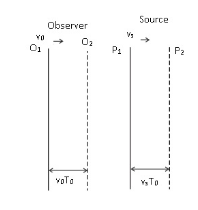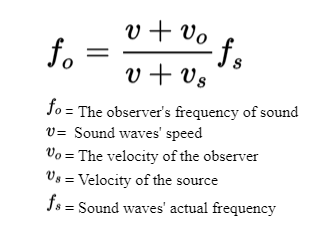Sound and light can both be affected by the Doppler Effect. The pitch of an object increases as it moves closer to you, which leads to a higher frequency of sound waves. As it moves away from you, the pitch comes down as well as the frequency of the sound waves. Ambulance sirens whose pitch drops as they pass by and red lights moving behind them are both examples of the Doppler Effect. According to the Doppler effect, each subsequent wave crest is emitted from a position that is closer to the observer when the source of the waves is moving towards the observer. This means that each wave takes slightly less time to reach the observer than the previous one.
Derivation of Doppler’s Law:
In order to derive the Doppler Effect equations, start by constructing the wavelength equations. By considering the observation distance the wave travels with the motion of the source, one can first derive the equations for a moving source and a stationary observer.
The frequency of a stationary source and a moving observer can be calculated by considering the difference in velocities between the stationary source and the observer. The equation for the general Doppler effect can be derived by combining the equations of both instances.
Case 1- stationary observer and moving source
- Let L be the distance between the observer and the source.
- P1 is the position of the source at time T1.
- It takes the wave L ⁄ v to reach an observer, where v is the speed of the sound wave.
- At time To, the source moves to position Po after a short period of time.
- T1 is the time it took the second wave to reach the observer.

Case 2- moving observer and stationary source
- Due to the source not moving, vs is replaced with -v0.
- Hence, v = v0 (1 + v0/v)

- Source S and observer O move at velocities of v0 and vs, respectively. A source emits the first crest of a sound whose velocity respects the medium at time t = 0, when they are located at positions O1 and P1. During the next crest, t = T0, they will have moved to O2 and P2, respectively, through distances of v0 T0 and vs T0 from the source.
Formula of Doppler’s Law

What is Doppler’s Effect?
The Austrian physicist Christian Doppler described it for the first time in 1842. Due to the relative motion of the observer and the source, the Doppler effect appears to be a difference in the frequency of light or sound waves as they travel from one point to another. In astronomical observations, Mössbauer effects studies and radar and navigation systems, this phenomenon is used. The Doppler effect is used to study the motion of stars and to find double stars, as well as being a key part of modern cosmological theories.
Conclusion
The Doppler Effect is a phenomenon that occurs when motion-related frequency changes occur. It was Edwin Hubble who discovered that the universe expands as a result of the Doppler Effect. These findings have major implications for astronomy and space technology. In astronomy, the Doppler Effect is used in light waves in relation to stars’ spectrums, which are not constant. The Doppler Effect can only be seen when absorption lines are away from defined frequencies, and different stars exhibit different absorption lines at distinct frequencies. Since the Doppler effect depends on moving objects, it is generally useful for determining the motion or speed of an object. There are many objects of interest: the speed of a car on a highway, the movement of blood through an artery, the rotation of a galaxy, or even the expansion of the universe.
 Profile
Profile Settings
Settings Refer your friends
Refer your friends Sign out
Sign out






